

Structure and Interpretation of Computer Programs. Let Over Lambda. Practical: Building a Unit Test Framework. Copyright © 2003-2005, Peter Seibel In this chapter you'll return to cutting code and develop a simple unit testing framework for Lisp. This will give you a chance to use some of the features you've learned about since Chapter 3, including macros and dynamic variables, in real code. The main design goal of the test framework will be to make it as easy as possible to add new tests, to run various suites of tests, and to track down test failures. Listes. LISP Tutorial Lecture 3: Data Abstraction. Binary Trees Suppose we want to create a new kind of recursive data type, our familiar binary trees.
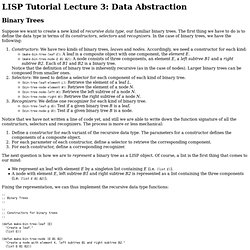
The first thing we have to do is to define the data type in terms of its constructors, selectors and recognizers. In the case of binary trees, we have the following: Constructors: We have two kinds of binary trees, leaves and nodes. Accordingly, we need a constructor for each kind: (make-bin-tree-leaf E): A leaf is a composite object with one component, the element E. Notice that we have not written a line of code yet, and still we are able to write down the function signature of all the constructors, selectors and recognizers. Define a constructor for each variant of the recursive data type.
Deep Emacs Lisp Part 2. Streams Last time we went through a lengthy development of monads in emacs lisp.
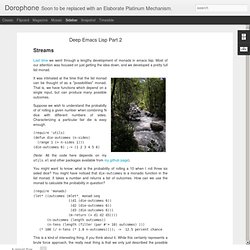
Most of our attention was focused on just getting the idea down, and we developed a pretty full list monad. It was intimated at the time that the list monad can be thought of as a "possibilities" monad. That is, we have functions which depend on a single input, but can produce many possible outcomes. Suppose we wish to understand the probabilty of of rolling a given number when combining N dice with different numbers of sides. (require 'utils) (defun die-outcomes (n-sides) (range 1 (+ n-sides 1))) (die-outcomes 6) ;-> (1 2 3 4 5 6) (Note: All the code here depends on my utils.el and other packages available from my github page).
You might want to know: what is the probability of rolling a 10 when I roll three six sided dice?
Lisp: Common Lisp, Scheme, Clojure, Emacs Lisp - Hyperpolyglot. A side-by-side reference sheet grammar and invocation | variables and expressions | arithmetic and logic | strings | listsarrays | dictionaries | functions | macros | execution control | file handles | file buffers | files | directoriesprocesses and environment | libraries and namespaces | objects | reflection | java interop General version used Versions used to verify data in the cheat sheet. show version How to determine the version.

Successful Lisp - Cover. Simplified Common Lisp reference.
Une petite balade avec la REPL du Lisp. Une petite balade avec la REPL du Lisp.
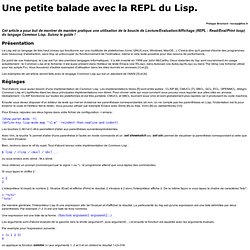
Cet article a pour but de montrer de manière pratique une utilisation de la boucle de Lecture/Evaluation/Affichage (REPL : Read/Eval/Print loop) du langage Common Lisp. Suivez le guide ! Le Lisp est un langage de très haut niveau qui fonctionne sur une multitude de plateformes (Unix, GNU/Linux, Windows, MacOS...). C'est-à-dire qu'il permet d'écrire des programmes avec beaucoup d'abstraction, sans trop se préoccuper du fonctionnement de l'ordinateur, même si cela reste possible pour des raisons de performance. Du point de vue historique, le Lisp est l'un des premiers langages informatiques : il a été inventé en 1958 par John McCarthy. Les exemples de cet article seront faits avec le langage Common Lisp qui est un standard de l'ANSI [3] et [4]. Planet Lisp. Lemonodor - a mostly lisp weblog. Emacs Lisp Tutorial: List & Vector. Nothing This page is a practical tutorial of Emacs Lisp's list and vector datatype.
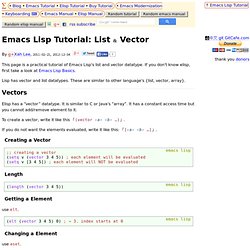
If you don't know elisp, first take a look at Emacs Lisp Basics. Lisp has vector and list datatypes. These are similar to other language's {list, vector, array}. Vectors. L-99: Ninety-Nine Lisp Problems. P01 (*) Find the last box of a list.
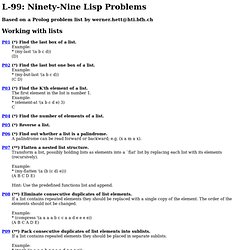
Example: * (my-last '(a b c d)) (D) P02 (*) Find the last but one box of a list. Example: * (my-but-last '(a b c d)) (C D) P03 (*) Find the K'th element of a list. The first element in the list is number 1. Prehacked - New Lisp web app - clutu. Yesterday I launched a new website, clutu. It's an online crossword you can play with friends. The whole thing is written in Common Lisp, and it runs on sbcl, on an ubuntu vps. I wrote it in my spare evenings, over the past six weeks. I'm pretty happy with the result. In the first 24 hours, more than 1000 games were played and over 1.5 million http requests were serviced (that includes a lot of ajax of course). Emacs. Learning Lisp Fast. Lisp is a big and deep language.
This quickstart is only intended to get you introduced to very basic concepts in Lisp, not any of the really cool stuff Lisp does. As such it's geared to how to do C in Lisp, not good functional style (no closures, no macros). It's enough to get you up to speed so you can more easily understand a good book (ANSI Common Lisp, etc.) The quickstart also does not teach many functions -- you'll need to root around in the ANSI Common Lisp index and play with some of the functions there.
The quickstart also shows you how to manipulate the command line, and to load and compile files. Don't be intimidated by the size of this file. If you're done with this tutorial, go on to Tutorial 2 and Tutorial 3. Legend. Common LISP Hints. Common LISP Hints Geoffrey J. Gordon <ggordon@cs.cmu.edu> Modified by Bruno Haible <haible@ma2s2.mathematik.uni-karlsruhe.de> and Peter Van Eynde <s950045@uia.ua.ac.be> Friday, February 5, 1993.
Practical Common Lisp. Common Lisp - Wikibooks, collection of open-content textbooks. The Common Lisp Wiki-book cover.

Common Lisp (CL) is a modern, multi-paradigm, high-performance, compiled, ANSI-standardized, prominent descendant of the long-running family of Lisp programming languages. The CL Hello World program reads as follows: (print "Hello World! ") Hello World! ``Condition Handling in the Lisp Language Family'' c by Kent Pit. This paper appears inAdvances in Exception Handling Techniques, edited by A.
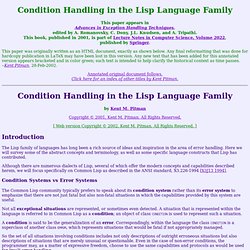
Romanovsky, C. Dony, J.L. Knudsen, and A. Tripathi. This book, published in 2001, is part of Lecture Notes in Computer Science, Volume 2022, published by Springer. This paper was originally written as an HTML document, exactly as shown below. Annotated original document follows.Click here for an index of other titles by Kent Pitman. Common Lisp: A Gentle Introduction to Symbolic Computation. This book, with minor revisions, is back in print from Dover Publications and can be purchased in paperback form at Amazon.com, Barnes & Noble, etc. An e-book version will be released in late February, 2013. Free software accompanying the book is also available.
This 1990 edition may be distributed in hardcopy form, for non-profit educational purposes, provided that no fee is charged to the recipient beyond photocopying costs. All other rights reserved. You may not redistribute the Postscript file, e.g., you may not put a copy on another web page, or include it on a CD-ROM. The Art of Lisp & Writing. Ignorance more frequently begets confidence than does knowledge.

–Charles Darwin. The Nature of Lisp. Monday, May 8, 2006 Introduction When I first stumbled into Lisp advocacy on various corners of the web I was already an experienced programmer.
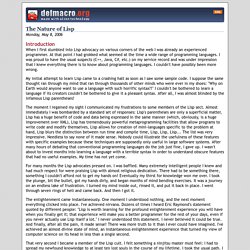
At that point I had grokked what seemed at the time a wide range of programming languages. I was proud to have the usual suspects (C++, Java, C#, etc.) on my service record and was under impression that I knew everything there is to know about programming languages. I couldn't have possibly been more wrong. La Nature de Lisp (trad google) Lisp for the Web. The following article and code has been updated as the book Lisp for the Web. You can get it for any price you want at Leanpub. by Adam Petersen, April 2008 With his essay Beating the Averages , Paul Graham told the story of how his web start-up Viaweb outperformed its competitors by using Lisp. Bastien Guerry. BD Casting SPELs in Lisp.
Emacs Lisp Reference Manual.
Arbre syntaxique. LISP Tutorial Lecture 3: Data Abstraction. Binary Trees. Ressources Web concernant le langage Common Lisp. Exercices de LISP. LEARNING LISP - Lists as Trees. Cliki. Trees as Linked Lists in Common Lisp. If you are starting to learn Common Lisp, and have already read the chapter about “Cons” from an introductory book (also called cons cells ), then you could try the following exercise. How to represent a tree using nothing but conses ; and abstract that implementation with functions to create and traverse the tree.
PLEASE NOTE , that if you need to represent trees in a production program you shouldn’t use lists as described here unless you have a good reason. Python for Lisp Programmers. Lisp collections - comp.lang.lisp. Rosetta. This result set should be accurate to within fifteen minutes of the last viewing. If is a language you like, or are interested in, please inform your fellow members of the Emacs Lisp community; this page can't be emptied without your and their participation.
LISP TD2 corrections. Tours de Hanoï. Simply Scheme contents. ABOUT LISP. Some History LISP (List Processing) is not simply a programming lanuage unique among all programming languages; it is a realization of a theoretical construction in the area of mathematical logic by Alonzo Church known as the lambda calculus of recursive functions. LISP is the physical relaization of this abstract computational tool, and was created by John McCarthy in the years 1956-1958. Thus, it is also one of the oldest and enduring programming languages, having only FORTRAN as rival. Though most modern implementations of LISP are very large languages with "environment lists" for saving function definitions and variable values, hundreds of functions, hence also of reserved words, additional data types such as numericals, strings, arrays, structures, macros, etc., the fundamentals are very few and can be used to display the unique thought processes that are involved in LISP programming.
Lisp lessons. PicoLisp Reference. Tutorial Lisp.